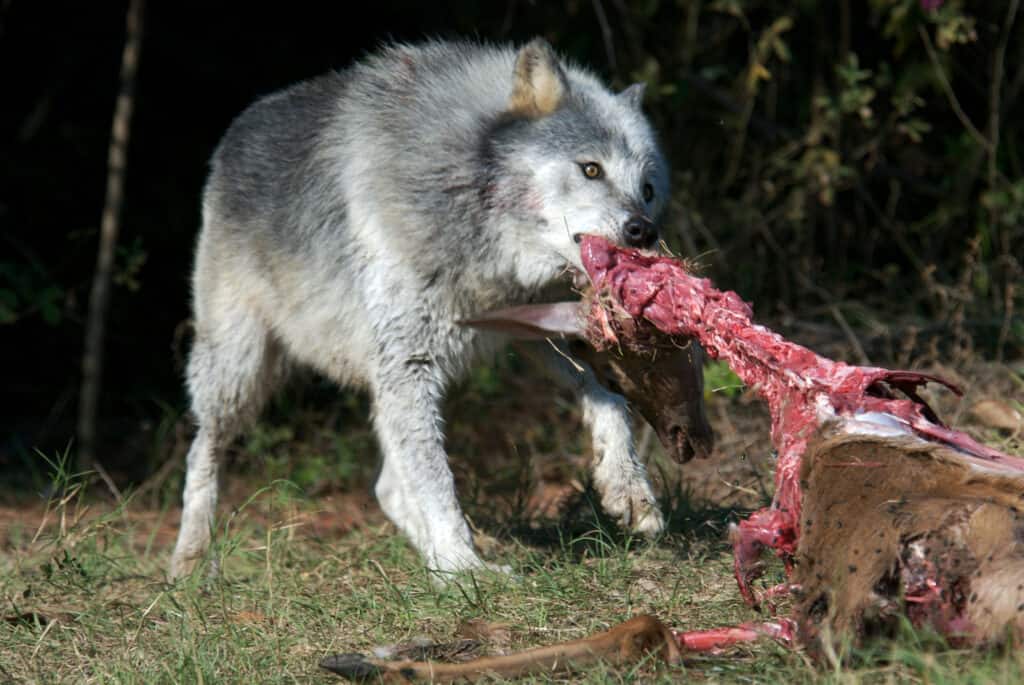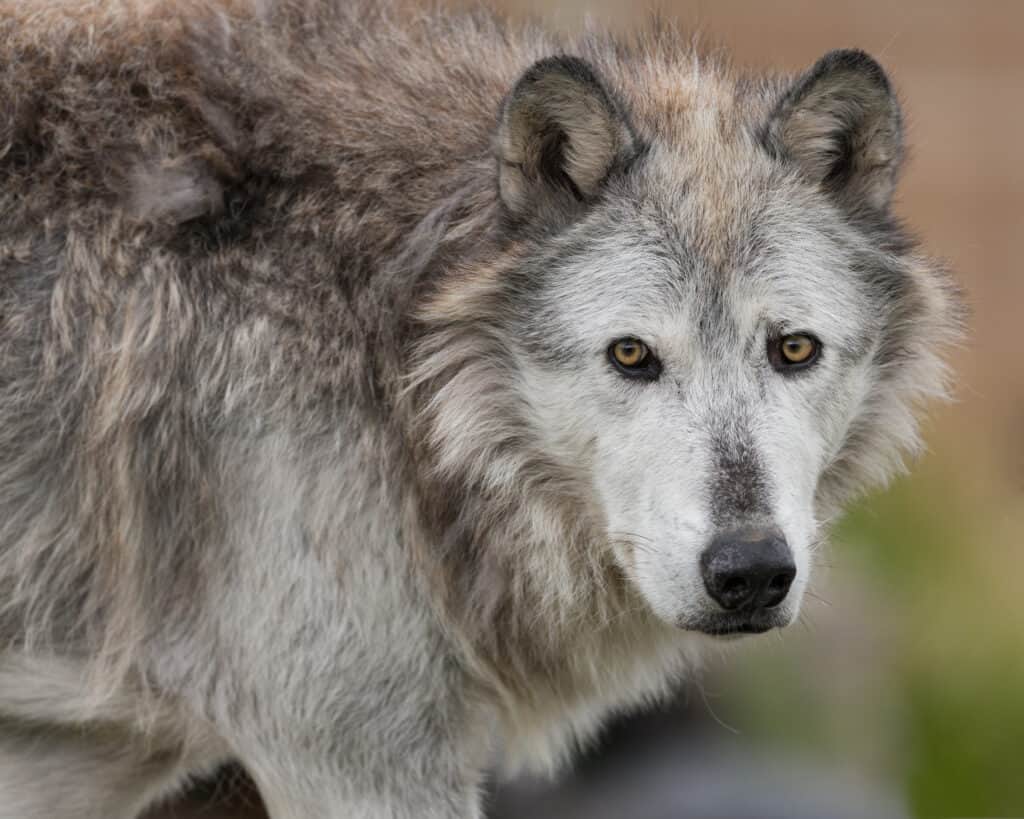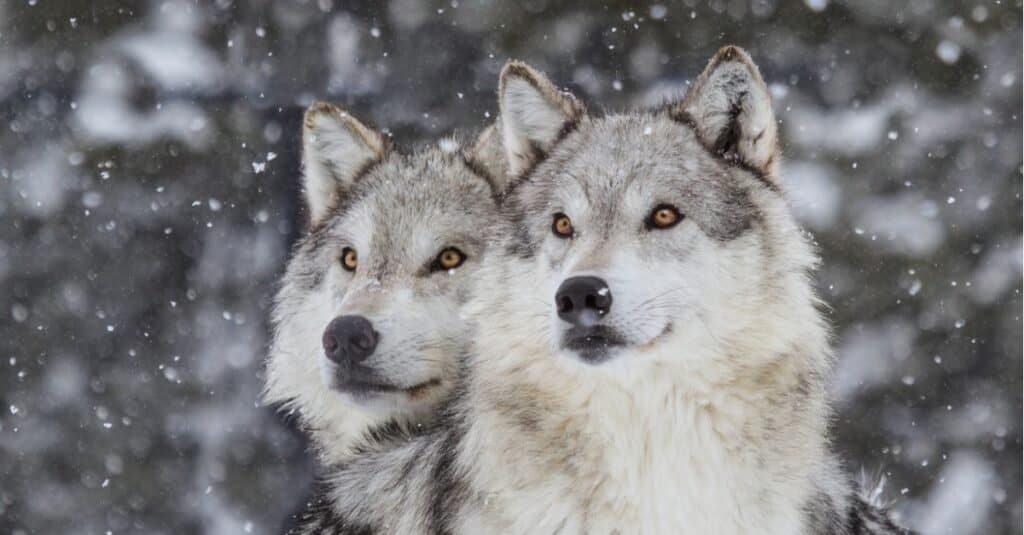Gray wolves, also called timber wolves, are large canines native to Eurasia and North America. Typically, their coats are grayish brown, making them instantly recognizable. Despite this, they have several variations in their coat colors that include a white underside and a gray or brown backside with facial markings. Typically, these powerful predators have a body length of three to five feet along with a tail length of one to two feet. Additionally, they live in packs. Wolves can live together in packs as small as two or as large as 15 wolves. A fascinating aspect of these canines is that they have one of the widest natural ranges of any other living mammal, aside from humans.
The gray wolf is a mysterious creature, so how much do you know about it? Let’s explore everything about what gray wolves eat as well as other fascinating facts about them!
What Do Gray Wolves Eat?

Daniel Korzeniewski/Shutterstock.com
Gray wolves eat a diet that consists of large-hoofed animals such as deer, elk, and bison as well as smaller prey such as beavers, rodents, and hares. They are classified as both carnivores and scavengers. As predators, gray wolves are capable of taking down a 1,000-pound moose. Keep in mind that gray wolves weigh anywhere between 60 and 145 pounds, depending on whether they are males or females. In other words, it shows that these animals are powerful hunters, that are capable of taking down animals who are much larger than them.
Despite their preference for large-hoofed animals, gray wolves will consume other foods when these are not available. It has been observed that they hunt a variety of rodents, snakes, lizards, waterfowl, insects, and even carrion. However, they tend to reserve these options as last resort. In North America, gray wolves will hunt white-tailed deer, Dall’s sheep, American bison, and caribou. The majority of Eurasian wolf populations, however, feed primarily on domestic livestock, including roe deer, red deer, moose, and wild boar. Meanwhile, Russian wolves have been known to feed on musk deer, reindeer, ibex, and wild goats.
In addition, gray wolves do not hunt randomly. In a study of gray wolves living in Yellowstone National Park, researchers found that wolves do not kill at random but choose their prey based on species, age, and sex when they hunt. It is too risky for wolves to attack their prey at random because of the risk of injury and death they might suffer.
Complete List Of What Gray Wolves Eat
Gray wolves are mostly carnivorous and hunt or scavenge for food. In order to sustain their diets, they consume a wide variety of animals. Despite being carnivores, they have also been observed eating fruits from time to time.
Here is a complete list of what gray wolves eat:
- Deer
- Bison
- Elk
- Caribou
- Bighorn sheep
- Beavers
- Rodents
- Hares
- Fish
- Birds
- Fruits such as apples, pears, figs, berries, cherries, and melons
- Waterfowl and their eggs
- Wild boar
- Moose
- Lizards
- Snakes
- Large insects
- Plants such as lily of the valley and nightshade
As you can see, the gray wolf diet is incredibly diverse. However, it is important to remember that they aren’t eating all of these different foods consistently. Their main sources of food come from large-hoofed herbivores. Some sources of food are only eaten when there is nothing else available such as lizards and large insects. Now that we know what gray wolves eat and what their diet consists of, we have a better understanding of this fantastic predator. Let’s take a look at how gray wolves hunt for food next.
How Do Gray Wolves Hunt For Food?

Nagel Photography/Shutterstock.com
Due to their status as apex predators, gray wolves have evolved keen hunting and survival skills. Their bodies are also equipped with all of the physical characteristics that help them take down prey. In addition to large canine teeth and strong jaws, gray wolves can run at speeds up to 37 mph. Although they are powerful all on their own, their real strength comes from hunting in packs.
Gray wolves are incredibly capable of hunting on their own. However, hunting as a pack ensures a higher success rate and also helps them mitigate injuries or death. In order to track down their prey, gray wolves rely on their excellent hearing and their incredible sense of smell. Both of these together help them to track down their prey. In the event that their prey happens to be particularly large, the gray wolves will divide and surround it once they have discovered it. In order to bring down a large animal, they usually bite the shoulders and sides first.
In spite of their speed and sharp teeth, wolves still face danger when hunting. Antlers and hooves that are large can cause serious problems for gray wolves if they aren’t careful. A moose or a caribou can greatly injure or kill a gray wolf if they’re not careful. Because of this, they choose prey carefully, looking for weak or small animals.
What Do Baby Gray Wolves Eat?
A baby wolf is known as a pup! When pups are first born they are completely reliant on their mothers for food. Because gray wolves are born with closed eyes, hunting is practically impossible for them. It is instead their mother’s milk that they drink at first. After about 10-14 days, the baby gray wolves will finally open their eyes. When they are three weeks old, they can finally begin eating meat.
At three weeks old, however, they still aren’t going out on hunts themselves. Instead, adult gray wolves will bring meat to them. Pups actually eat regurgitated meat that the adults bring back from their hunts. Although this might not sound particularly appetizing to us, puppies need it to survive. A pup will begin hunting larger animals with the pack when he or she is six months old.
How Do Gray Wolves Impact The Ecosystem With Their Diet?

iStock.com/rogertrentham
There is no doubt that gray wolves play an important role in protecting the environment. Their presence can influence the behavior of wildlife across a wide range of ecosystems since they are apex predators. Gray wolves, for example, play an important role in controlling deer and elk populations, which benefits many other plants and animals. Additionally, grizzly bears and scavengers feed on the carcasses of their prey, which redistributes nutrients. Our ecosystem relies heavily on wolves and they are incredibly important to keeping animal populations in check.
The post What Do Gray Wolves Eat? appeared first on AZ Animals.
from Animal News, Facts, Rankings, and More! - AZ Animals https://ift.tt/F7qhynS